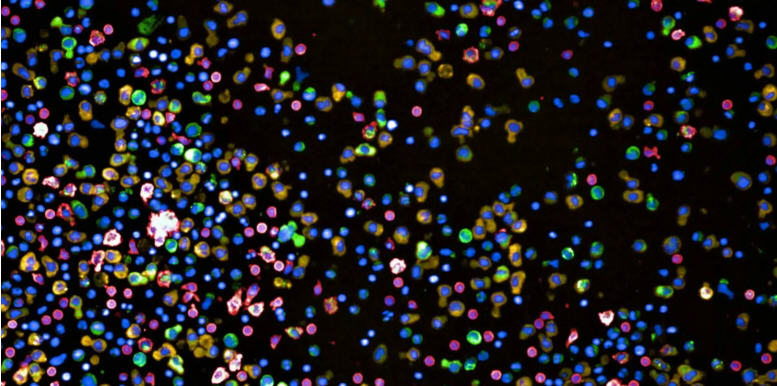博文
击败血癌:有效治疗的新策略
||
击败血癌:有效治疗的新策略
诸平
据瑞士苏黎世联邦理工学院(ETH Zurich, Zurich, Switzerland)2023年5月7日提供的消息,击败血癌:有效治疗的新策略(Defeating Blood Cancer: New Strategies for Effective Treatment)。相关研究结果于2023年4月20日已经在《自然癌症》(Nature Cancer)杂志网站发表——Klara Kropivsek, Paul Kachel, Sandra Goetze, Rebekka Wegmann, Yasmin Festl, Yannik Severin, Benjamin D. Hale, Julien Mena, Audrey van Drogen, Nadja Dietliker, Joëlle Tchinda, Bernd Wollscheid, Markus G. Manz, Berend Snijder. Ex vivo drug response heterogeneity reveals personalized therapeutic strategies for patients with multiple myeloma. Nature Cancer, DOI: 10.1038/s43018-023-00544-9. Published: 20 April 2023. https://doi.org/10.1038/s43018-023-00544-9
参与此项研究的除了来自瑞士苏黎世联邦理工学院的研究人员之外,还有来自瑞士生物信息学研究所(Swiss Institute of Bioinformatics, Lausanne, Switzerland)、苏黎世大学医院和苏黎世大学(University Hospital Zurich and University of Zurich, Zurich, Switzerland)、苏黎世大学儿童医院(University Children’s Hospital Zurich, Zurich, Switzerland)、苏黎世综合癌症中心(Comprehensive Cancer Center Zurich简称CCCZ, Zurich, Switzerland) 的研究人员。
多发性骨髓瘤(Multiple myeloma)是一种罕见的血癌,由于异常浆细胞(plasma cells)过度增殖而发生。浆细胞是一种特殊类型的白细胞,通过在骨髓(bone marrow)和淋巴结(lymph nodes)中产生关键的抗体,在免疫系统中起着至关重要的作用。
尽管有越来越多的药物和治疗方法被批准,包括免疫疗法(immunotherapy),多发性骨髓瘤仍然是无法治愈的。确诊后患者的平均预期寿命仅为5年。
其中一个主要的挑战是,即使在治疗后,癌症仍有复发的趋势。这是因为治疗使癌细胞对所使用的药物产生更强的抵抗力,直到最终,经过几轮治疗,没有有效的选择。
为了解决这个问题,苏黎世联邦理工学院(ETH Zurich)的研究人员已经调整了他们的筛选平台来寻找解决这个问题的方法,从而为更成功的治疗结果提供了新的希望。
显微镜下活检(Biopsies under the microscope)
研究人员正在使用贝伦德·斯内德(Berend Snijder)教授开发的高通量筛选方法——“显药镜”(pharmacoscopy)来测试各种治疗方法对患者癌细胞的效果。
这种最先进的方法允许几百种不同的治疗组合在体外同时进行测试。通过分析细胞对每种治疗的反应,他们可以确定哪种方法对每个病人最有希望。
为了做到这一点,活组织切片的细胞被放置在有384个小孔的特殊板上,每个孔含有不同的潜在治疗物质组合。24小时后,使用不同的抗体对细胞进行染色,并使用自动显微镜生成的图像评估它们的反应。然后使用深度学习算法来识别和分类细胞类型。该过程基本上是自动化的,允许对结果进行有效和准确的分析。
分别检测了138例活组织检查(138 biopsies individually tested)
研究人员使用显药镜仔细检查了来自89名不同阶段多发性骨髓瘤患者的138份骨髓活检,包括新诊断的和未治疗的,以及接受了多轮治疗的患者。
目的是观察癌细胞在每次活检中对各种批准的药物和药物组合的反应。根据细胞的外观,研究人员可以确定每个患者的最佳治疗方案。
尽管贝伦德·斯内德实验室以前曾在其他类型的血癌(如淋巴瘤和白血病)的类似研究中使用显药镜,但该平台必须适用于这次骨髓瘤研究。
希望有更有效的治疗方法(Hope for more effective treatments)
苏黎世联邦理工学院和苏黎世大学医院(University Hospital Zurich)的研究人员所做的开创性工作为多发性骨髓瘤的更有效治疗带来了希望。通过使用显药镜测试数百种治疗方法,研究人员能够为每位患者确定新的,更有效的治疗方案。
这种新的个性化医疗方法可转移到诊所,因此可以帮助医生在早期阶段为患者找到最佳选择。“然而,首先,我们必须在临床试验中进一步验证这种方法,”贝伦德·斯内德说。
现在,贝伦德·斯内德实验室希望进一步开发该平台,将其应用于实体肿瘤。与血癌不同,实体瘤必须先解离到一定程度,然后才能在384孔板中进行检测。他们目前正在调整脑瘤等的筛查平台。
本研究得到了H2020欧洲研究理事会(European Research Council)在欧盟地平线2020研究与创新计划(European Research Council under the European Union’s Horizon 2020 Research and Innovation Program SCIPER; 803063)、ETH领域的战略重点——个性化健康及相关技术研究(Personalized Health and Related Technologies Strategic Focus Area of the ETH Domain project no. 2022-601)的支持或资助。
上述介绍,仅供参考。欲了解更多信息,敬请注意浏览原文或者相关报道。
Next-generation microscopy:'Pharmacoscopy' enables immunomodulatory drug discovery by analyzing immune cell interactions
Multiple myeloma (MM) is a plasma cell malignancy defined by complex genetics and extensive patient heterogeneity. Despite a growing arsenal of approved therapies, MM remains incurable and in need of guidelines to identify effective personalized treatments. Here, we survey the ex vivo drug and immunotherapy sensitivities across 101 bone marrow samples from 70 patients with MM using multiplexed immunofluorescence, automated microscopy and deep-learning-based single-cell phenotyping. Combined with sample-matched genetics, proteotyping and cytokine profiling, we map the molecular regulatory network of drug sensitivity, implicating the DNA repair pathway and EYA3 expression in proteasome inhibitor sensitivity and major histocompatibility complex class II expression in the response to elotuzumab. Globally, ex vivo drug sensitivity associated with bone marrow microenvironmental signatures reflecting treatment stage, clonality and inflammation. Furthermore, ex vivo drug sensitivity significantly stratified clinical treatment responses, including to immunotherapy. Taken together, our study provides molecular and actionable insights into diverse treatment strategies for patients with MM.
https://blog.sciencenet.cn/blog-212210-1387559.html
上一篇:2351黄山的几张照片
下一篇:纠缠量子电路进一步反驳了爱因斯坦的局部因果关系概念
